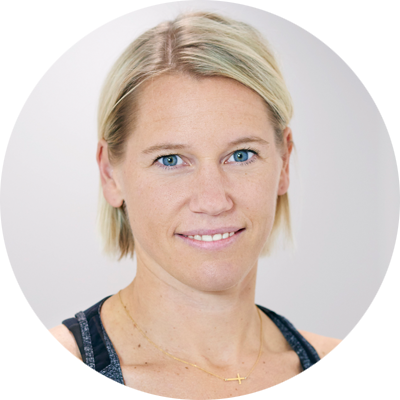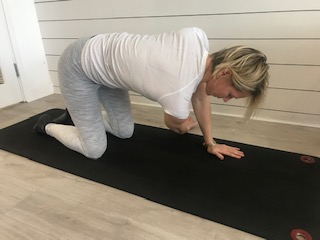Pilates for Golf
Louise Aylwin worked privately on the men’s European Tour for four years and still regularly travels with the Ladies European Tour for Sports Physiotherapy International. When Louise is not travelling, she works at Complete Pilates and Complete Physio in London.
Louise regularly advises her professional golf clients to use Pilates as a form of rehabilitation and activation before they play. Pilates can not only help reduce the number of injuries golfers suffer, but can also improve movement and therefore improve their game.
Why do you feel Pilates and golf work well together?
In golf you are constantly twisting your body on a drive, squatting down to measure a putt or leaning over to pick up a ball. It requires repeating the same essential movements over and over again over a long period of time. As a result, some muscles become overused and others weaken, causing an imbalance. Pro golfers are now turning to Pilates, as an essential training tool that keeps their body in balance and actually improves their performance. Both Pilates and golf share same basic principles. The golf swing principles are fluid motion, precision, accuracy and power, and Pilates principles focus on control, concentration, precision, flow of motion and breathing.
How about the combo of Physio and Pilates for golf performance enhancement/injury rehab?
Pilates helps you improve your core structure which includes building back muscles and strengthening the abdominals. It helps you to mobilise the spine in a variety of directions. It also helps increase overall flexibility, strength and balance and increases range of motion in the hips, pelvis and shoulders. It can also contribute to concentration through focused diaphragmatic breathing.
The performance benefits for golfers are as follows:
- Attain an optimal backswing and follow-through with increased range of motion in shoulders and trunk.
- Gain more distance and power because of added hip and torso flexibility.
- Have stronger and bigger hip turns for greater power through rotation.
- Create a smoother and more powerful swing due to evenly conditioned back muscles.
- Maximize balance and alignment while rotating.
- Decrease fatigue because of less strain on the body.
- Hold a body position long enough to play through a shot.
- Play without pain.
How specifically do they complement each other? Are there are certain aspects of Pilates that help with the parts of the golf game?
An underlying fault in a swing is the body itself. A limited shoulder rotation can affect golf in either the back or down swing. This could be improved through exercises from Pilates to improve shoulder rotation, torso rotation, hip rotation, and shoulder strength and oblique slings. The limitations need to be addressed at their physical source.
Five simple Pilates home exercises that could help a golfer player improve their game.
- Bridging: improves glutes strength.
- Thread the needle: improves your spine rotation and shoulder flexibility.
- Book openings: improves your spine rotation and flexibility in your chest.
- Quadraped: improves core and shoulder stability and opposite slings.
- Criss cross: improves core strength and torso rotation.
- Bridging
Goal: this exercise improves your glutes strength and helps promote stability. The glutes area is a power source for a performance swing.
Top tips for performing the bridge exercise:
- Don’t bridge up on to your neck. You should only bridge to the point where your shoulder blades are still on the mat.
- Keep your chest soft and hips high when you are up in your bridge. You should feel your glutes and hamstrings work when you’re in this position.
- Inhale to widen between scapulae. Exhale and move with your breath! Use a sigh as you move your spine – it will support the movement, aid relaxation and help to activate the right muscles.
- Initiate the spine articulation rolling up until standing between shoulder blades. Inhale and lengthen the back of the neck. Exhale, soften the sternum and roll spine down starting from the shoulder blades. When your lower ribs have met the floor start to relax your sit bones to return to neutral zone pelvis.
- Use a band around your thighs (and press into it) if you feel like your legs are falling inwards. Put a ball between your knees if you feel your legs tend to roll outwards.
Common faults: Excessive posterior tilt at the beginning at the end of the movement. Tilting of pelvis, overuse of shoulder and neck muscles.
Sets/reps 10 x 2 sets
- Thread the needle
Insert two pictures (one missing and turn 180)
Goal: An inability to rotate the upper torso is detrimental to power generation and swing.
Top tips for performing the exercise
- Come on to all fours.
- Exhale in a threading motion, bring one arm through the space you’ve created between your hand and thigh.
- Allow your other arm to bend so that you can rest your shoulder on the ground for a deep twist.
- Return to all fours and repeat on the other side.
- Allow your top spine to twist.
- Repeat several times on both sides.
Sets/reps 5 x left side and 5 right side
Common faults: using your hips, keep hips over knees remember it is the trunk that is rotating for this exercise.
- Book openings
Goal: To improve spine mobility and rotation, to improve shoulder and hip mobility.
Insert two pictures (one missing)
Top tips for performing the book opening exercise:
- Exhale as you move! Sigh with an open mouth as you open your arms up towards the ceiling and start to twist your spine – you should feel your chest softening as you do so. This should help you access the top part of your spine. Exhale to return to start position initiating movement from the rib cage.
- Reduce your range of movement if you feel this in your lower back. Or move your knees forwards so that they are in line with your hips. This exercise is designed to mobilise your upper spine.
- Keep your knees stacked throughout this movement.
- Turn your head as you open your chest up to the ceiling. It can help to imagine carving an arc with your nose.
- Prop your head up with a small pillow.
Sets/reps –hold 3-5 seconds per rotation alternate sides and repeat 5 reps each side.
Common faults: moving the arm only, moving the trunk and the hip with no spinal rotation. Not moving the head and neck.
- Quadruped
Goal: improve core and shoulder stability opposite slings.
- Come on to all fours, with your wrists under armpits and knees under hips.
- Exhale and extend one leg out behind you then widen your sit bones as you return it. Swap legs.
- Take one arm out in front of you, return it and then repeat on the other side.
- Exhale, move one arm and opposite leg into extension.
- Repeat with other arm and leg.
- Keep shoulders and hips level as you move.
Common faults: Don’t allow your spine to sag at the abdomen and shoulders. Keep a neutral spine and don’t allow your shoulder blades to collapse, scapulae winging, excessive protraction and retraction. Avoid hyper-extension in wrists and elbows. Re-set after each repetition to keep good pelvic posture and stability.
10 reps each side
- Criss-cross
Goal: to improve abdominal strength and torso rotation.
Insert picture (one missing)
- With your hands behind your head and legs in table top, curl your upper body up until your shoulder blades are off the mat.
- Rotate your upper body and draw one knee to the chest and extend the other leg out and away. Aim the shoulder to the knee. Maintain the upper torso off the mat.
- Come back to the centre and exhale to the other side.
- Keep repeating.
Sets/reps 10 each side.
Common faults: Excessive chin poking, abdominals bulging or popping forward, initiating the movement from the elbows instead of the torso.
Louise Aylwin

Physiotherapist works with top male and females golfers on the Ladies and Men’s European Tours.
@laphysio
@complete_pilates
www.complete-pilates.co.uk
www.spiprohealth.com
If you have any questions about these exercises please see your Pilates instructor or for further information please contact Louise by e-mail on louise@laphysio.co.uk
July 18, 2020 9:18 am









